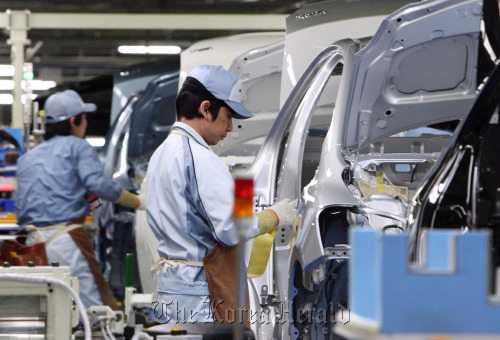Japan’s machinery orders fell for the first time in four months in April, an indication that companies are reluctant to spend after the March 11 earthquake and tsunami.
Factory orders declined 3.3 percent in April from March, when they rose 1 percent, the Cabinet Office said Monday in Tokyo. Orders, an indicator of capital spending in three to six months, were projected to increase 1.7 percent, according to the median forecast of 30 economists surveyed by Bloomberg News.
Sales at companies from Ricoh Co. to Toyota Motor Corp. are falling after the disaster caused parts and power shortages, disrupting production. Signs of a cooling U.S. economic recovery underscore the difficulty Japan will have in relying on exports to propel growth and help it recover from the quake that has left more than 23,000 people dead or missing.
“Today’s data was disappointing,” said Junko Nishioka, chief economist at RBS Securities in Tokyo. “With rising concern about global growth slowing, Japanese companies are likely to revise down their capital spending plans.”
Factory orders declined 3.3 percent in April from March, when they rose 1 percent, the Cabinet Office said Monday in Tokyo. Orders, an indicator of capital spending in three to six months, were projected to increase 1.7 percent, according to the median forecast of 30 economists surveyed by Bloomberg News.
Sales at companies from Ricoh Co. to Toyota Motor Corp. are falling after the disaster caused parts and power shortages, disrupting production. Signs of a cooling U.S. economic recovery underscore the difficulty Japan will have in relying on exports to propel growth and help it recover from the quake that has left more than 23,000 people dead or missing.
“Today’s data was disappointing,” said Junko Nishioka, chief economist at RBS Securities in Tokyo. “With rising concern about global growth slowing, Japanese companies are likely to revise down their capital spending plans.”

The yen traded at 80.63 per dollar at 10:39 a.m. in Tokyo, compared with 80.36 before the report was published. The Nikkei 225 Stock Average fell 0.75 percent as Toyota Motor said profit will fall almost a third this year and after the unexpected drop in machinery orders.
The report adds to weak data for April that implies the recession will drag on into the current quarter. Exports had their biggest drop since October 2009, the unemployment rate climbed and households cut spending.
Japan’s economy may shrink at a 2.97 percent annual pace in the second quarter before returning to growth in the second half of the year, according to the average forecast of 43 economists in a survey by the government-affiliated Economic Planning Association released last week. Gross domestic product shrank at an annualized 3.5 percent rate in the first quarter.
“The problem of insufficient power has not been resolved and will remain a drag on the economy going forward,” in addition to growing evidence of a global slowdown, Ryutaro Kono, chief economist at BNP Paribas Securities Japan Ltd. in Tokyo, said before the report.
Toyota last week forecast a surprise drop in profit, citing disruptions from the quake and a stronger currency. It projected that net income may fall to 280 billion yen ($3.5 billion) in the 12 months ending March 31, missing the 422 billion yen average of 13 analyst estimates compiled by Bloomberg.
Ricoh, the Japanese office-equipment maker, said last month that it plans to cut 9 percent of its workforce over the next three years to revive profit growth amid falling sales.
The government revised historical machinery orders data to reflect its new calculation method that excludes mobile phones. From a year earlier, factory orders fell 0.2 percent in April, Monday’s report showed.
There are also signs that the economy is starting to recover from the March temblor. Bank of Japan Governor Masaaki Shirakawa said on June 1 that companies are fixing disruptions in their supply chains at a faster pace than expected as they rush to repair their facilities. Industrial production rose in April, rebounding from a record plunge in March, and companies said they plan to boost output in May and June. (Bloomberg)
“Supply constraints are easing faster than expected and production is returning to normal,” said Yuichi Kodama, chief economist at Meiji Yasuda Life Insurance Co. in Tokyo. “The economy may be headed for a V-shaped recovery from the third quarter.”
(Bloomberg)








![[Kim Seong-kon] Democracy and the future of South Korea](http://res.heraldm.com/phpwas/restmb_idxmake.php?idx=644&simg=/content/image/2024/04/16/20240416050802_0.jpg&u=)







![[KH Explains] Hyundai's full hybrid edge to pay off amid slow transition to pure EVs](http://res.heraldm.com/phpwas/restmb_idxmake.php?idx=652&simg=/content/image/2024/04/18/20240418050645_0.jpg&u=20240418181020)

![[Today’s K-pop] Zico drops snippet of collaboration with Jennie](http://res.heraldm.com/phpwas/restmb_idxmake.php?idx=642&simg=/content/image/2024/04/18/20240418050702_0.jpg&u=)